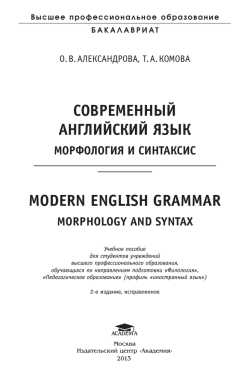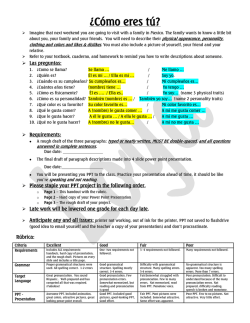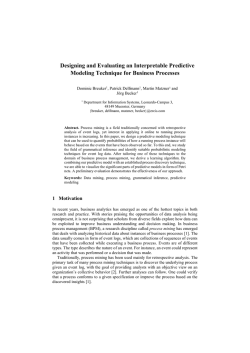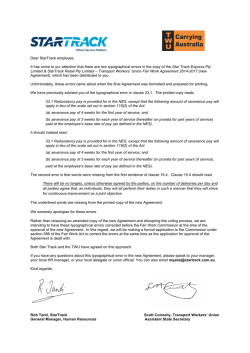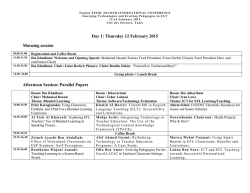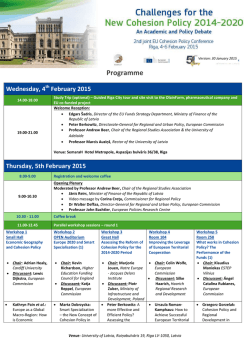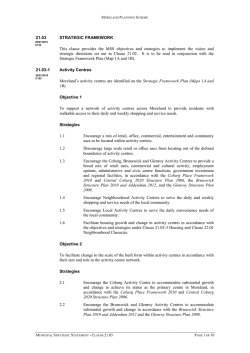
Impact of Intensive Reading on the Written Performance of Thai
Vol. 3 (2011) 3-‐14 University of Reading ISSN 2040-‐3461 L A N G U A G E S T U D I E S W O R K I N G P A P E R S Editors: D.S. Giannoni and C. Ciarlo Impact of Intensive Reading on the Written Performance of Thai University EFL Writers Yutthasak Chuenchaichon This paper presents an investigation of the impact of incorporating reading into writing on the EFL writing of 54 second-year English major students at Naresuan University, Thailand. Intensive reading tasks were incorporated into a paragraph-writing classroom. The change in students’ written performance in terms of grammatical accuracy, grammatical complexity, and coherence and cohesion were examined. The findings revealed the positive impact that reading can have on paragraph-writing development, particularly as grammatical complexity is concerned. These findings highlight the benefits of paragraph-writing instruction in such a context and may help writing teachers to recognise the importance of reading tasks for EFL writing classrooms in university contexts. 1. Introduction In university contexts, as Parks et al. (1986) point out in a writing guide for L1/L2 learners, much of what students write is expository. They are usually asked to submit such assignments as essays, reports, or research papers, and to succeed in these they need the right skills associated with effective expository prose. These include an ability to organise texts, to develop ideas adequately, and to link ideas logically; the authors explain that “one good way to acquire these basic writing skills is to start on the level of the paragraph” (ibid.: 1). Paragraph writing is a very important aspect of written production that L2 learners have to acquire in order to fulfil their writing assignments. As claimed by a number of researchers (cf. Kintsch & van Dijk 1978; van Dijk & Kintsch 1983; Singer 1990; Grabe & Kaplan 1996; Duncan 2007), the paragraph is one of the most important conventions when presenting a text. It presents readers with a coherent set of ideas and constitutes one of the fundamental units of any instance of written discourse, as pointed out by a vast number of researchers on paragraph theory in English composition (e.g. Angus 1862; Bain 1866; Christensen 1965; Rodgers 1966; Cohan 1976; Eden & Mitchell 1986; Grabe & Kaplan 1996; Duncan 2007). In Thai university contexts, however, the pedagogic value of paragraph writing has been largely neglected. There is a gap in the literature that this study aims to address. Among the various options available to EFL instructors, the use of a reading-intowriting-method would be particularly beneficial to students’ paragraph-writing abilities, although “for many years reading and writing in ESL classrooms were taught separately” (Carson & Leki 1993: 1) and were seen as technical skills limited to the performance of specific tasks (Flower 1990; Carson & Leki 1993). Since the 1980s, however, a large number of studies (Stotsky 1983; Carson et al. 1990; Carson & Leki 1993; Flahive & Bailey 1993; Grabe 2003; Rodriguez Kessler 2006; Farahzad 2010) have supported the relationship between reading and writing, claiming that the two skills are inextricably connected and share similar cognitive processes of meaning construction. 2. Theoretical background In the past two decades, the relationship between reading and writing and the role of reading in the development of writing have been explored by a number of researchers from a variety of perspectives; for example, education (Hirvela 2001), learning psychology (Flower et al. 1990; Kellogg 1994), applied linguistics (Grabe 2003), and sociolinguistics (Kucer 2005). In other words, this relationship can be viewed in terms of both cognitive and social perspectives of learning (Carson & Leki 1993; Belcher & Hirvela 2001). The focus here, however, will be on the cognitive demands of reading/writing rather than its social implications, as the EFL students targeted in this study are motivated mainly by a need to meet classroom and/or task requirements. Thus, the theoretical overview that follows considers the relationship between reading and writing by taking a cognitive view of learning in L1 and L2 contexts. 2.1. L1 settings For Carson (1990: 89), the most influential approaches developed over the years to account for the reading/writing interaction in L1 contexts follow one of the following hypotheses: • The directional hypothesis stresses that “reading and writing share structural components such that the structure of whatever is acquired in one modality can then be applied in the other”; for example, when an L1 learner reads a passage, he/she can recognise a rhetorical pattern (e.g. comparison and contrast) in that text and then reproduce it in his/her writing. In this model, “this transfer of structural information can proceed in only one direction”, that is, from reading to writing or from writing to reading. A great number of studies indicate, however, that reading has a more positive impact on writing than vice-versa (i.e. reading-to-writing directional model). Their findings reveal that reading has a positive impact on L1 students’ writing: for example, Eckhoff (1983) showed that the participants in the group that received reading texts that match the style and complexity of literary prose tended to use more complex verb forms, subordinate clauses, and infinitive and participle phrases. Taylor and Beach (1984) suggest that reading enhances the quality of students’ expository writing, particularly in text structure. Additionally, studies by Clark (1935) and Elley et al. (1976) found that incorporating reading into the composition classroom can help students improve their grammar more than students who were taught only formal grammar. • The nondirectional hypothesis can be viewed as an interactive model, where “reading and writing are said to derive from a single underlying proficiency, the common link being that of the cognitive process of constructing meaning” (Carson 1990: 90). Shanklin (1982) notes that since reading and writing are constructive processes, they must be connected. Squire (1983: 582) adds that writing actively engages the writer “in constructing meaning, in developing ideas, in relating ideas, in expressing ideas”, while reading requires the reader to “reconstruct the structure and meaning of ideas expressed by another writer”. This implies that reading and writing basically reflect the same cognitive process of meaning construction. The nondirectional model assumes therefore that reading and writing interact with each other and that their skills can be transferred to each other. • Finally, the bidirectional hypothesis “is the most complex model, which includes the claim that reading and writing are interactive, but also claims that they are interdependent” (Carson 1990: 92). Shanahan stresses that “what is learned at one stage of development can be qualitatively different from what is learned at another stage of development” (1984: 467). That is, the bidirectional model argues that the skills gained in reading and writing can be transferred to each other at different developmental stages. 4 Taken together, the three approaches provide valuable insights into the writing-reading interaction, but writing teachers should consider the cognitive dimension of this interaction and take advantage of similarities also when designing writing activities in the L2 classroom. 2.2. L2 settings With respect to the reading/writing relationship in L2 contexts, Grabe (2003) lists three dominant approaches besides the directionality hypothesis: • The interdependence hypothesis was first proposed by Cummins (1979: 233) to indicate that “the level of L2 competence which a bilingual child attains is partially a function of the type of competence the child has developed in L1 at the time when intensive exposure to L2 begins”. This also applies to L2 literacy development and Grabe (2003) points to an underlying common proficiency that can transfer literacy abilities from the L1 to the L2. For Cummins (1979) the hypothesis is complicated by the fact that L2 learners must attain a reasonable proficiency to allow the transfer of their common literacy abilities from the L1. It must be noted, however, that these abilities relate to the development of L2 reading skills rather than L2 writing skills (Grabe 2003). • According to the language threshold hypothesis, transfer is not the only major influence on L2 literacy development. Having a reasonable L2 proficiency is crucial to the transfer of L1 literacy skills to the L2 (see Grabe 2003). Learners need to achieve a threshold level of L2 language skills for their L1 literacy to be transferred. However, the problem here is that no one knows exactly what that level may be. • The extensive reading hypothesis assumes that extensive reading can improve writing skills (Grabe 2003). It was first put forward in Krashen’s (1984) review of L1 studies on the relationship between extensive reading and writing skills development among high school students (cf. Donalson 1967; Applebee 1978) and college freshmen (cf. Woodward & Phillips 1967; Illo 1976; Ryan 1977). Students who undertook extensive voluntary reading of magazines, newspapers and books at home improved their writing abilities more than the students who read less. The hypothesis concludes that learners with greater exposure to print over a long period of time can improve their literacy. It emphasises the positive impact of extensive reading on the literacy of L2 writing learners. Grabe (2003) notes that L2 research does not usually discuss the reading/writing relationship in the way L1 research does, apart from the effects on writing of exposure to print. In fact, L2 reading-writing relations can be viewed in terms of directionality: reading improves writing or writing improves reading (the directional hypothesis); there is no direct relationship between reading and writing (the nondirectional hypothesis); or reading and writing improve each other (the bidirectional hypothesis). To date, there is evidence in L2 research supporting the notion of directionality (cf. Asención 2008; Plakans 2008; Yoshimura 2009) and mainly the reading-to-writing directional model, which claims that reading can positively impact written performance in terms of rhetorical organization, language use, and content information. It should be noted that in a number of L1 and L2 studies (Spivey & King 1989; Stein 1990; Plakans 2008; Yoshimura 2009) students read from a source text (i.e. a related text on the topic they will write about) to enhance writing development. The present study, however, explores the impact on writing development of texts dealing with topics different from those to be written about but belonging to the same genre. In other words, it explores the use of intensive reading through a ‘reading into writing method’. This allows students to notice, among other things, the correct use of grammar, how to compose different types of sentences, how to organise ideas within a text and make logical links between sentences. To conclude, it is worth noting that recent research on reading-writing relations in L2 university contexts mainly focuses on the development of essay writing through the use of extensive reading (Elley 1996; Tsang 1996; Chen 2006) and reading from source texts 5 (Asención 2008; Plakans 2008; Yoshimura 2009). No L2 research to date has considered the development of paragraph writing through intensive reading (i.e. reading and analysing texts), or reading on topics different from those to be written about in the composition classroom, particularly in EFL university contexts. Furthermore, there is no published research examining paragraph-level writing and reading-writing relations in Thailand. It is a gap that this study aims to redress by exploring the impact of intensive reading on the paragraph writing ability of Thai university EFL writers. The focus is on three distinct aspects of written texts: grammatical accuracy, grammatical complexity, and coherence and cohesion. It should be noted that the role of reading-into-writing in L2 contexts can be explored in many aspects of written texts (for example, content, vocabulary, text organisation, and language use). This research focuses on how reading impacts the development of grammatical accuracy, grammatical complexity, and coherence. These are important characteristics of a good paragraph and are areas that students might improve using the kind of reading texts adopted here. Other aspects of written texts (e.g. content and vocabulary) could be the object of another study. 3. Methodology 3.1. Participants The participants were 54 (M=7, F=47) undergraduates attending a four-year Humanities programme, aged between 20 and 22. They were all Thai students with lower intermediate nonnative English enrolled in the university’s paragraph-writing course for the 2009 academic year. They were second-year students majoring in English and had the same academic background (having taken the same academic courses in their first year). The participants were divided into two groups: a control group and an experimental group. Those in the experimental group were 26 (M=3, F=23) and those in the control group 28 (M=4, F=24). The former were taught using the reading-into-writing method while the latter were not. 3.2. Writing assessment task To examine the written performance of students and assess the development of their paragraph-writing abilities, the same expository writing topic (“What do you like about life at university?”) was used both pre-test and post-test. This topic was chosen because it was accessible to the students and could be covered in one paragraph; in addition, it was openended and familiar. It should be noted that the topic was piloted and found to be suitable for use. The piloting revealed that the participants could write on this topic and reported that they were comfortable with it. All the participants were instructed to write a free-standing paragraph of at least 10 sentences (100-150 words) about the topic within 45 minutes at one sitting and under the same test conditions. They were allowed to use dictionaries and were given paper for notetaking. The bilingual and/or monolingual dictionaries were not checked but included a range of titles. It is worth noting that this 45 minute one-task classroom test is the only evidence of the students’ writing ability. Its instructions are attached in Appendix 1. 3.3. Procedure Both groups received the same paragraph-writing instruction and weekly paragraph writing tasks. The course consisted of ten weeks of lessons based on the coursebook Paragraph Writing: From Sentence to Paragraph (Zemach & Islam 2005). Every week students were assigned paragraph-writing tasks related to the lessons. 6 Students in the experimental group were asked to read and analyse a range of paragraphlength texts twice a week and do associated reading tasks. A reading task might require students to read a text, identify the part of speech of given words and describe their function in the sentence. They might also be asked to read the texts, underline supporting sentences and circle the concluding sentence of each text. Alternatively, they might be asked to underline the compound sentences and circle the complex sentences in each text, and look at the use of connecting words in compound sentences and complex sentences. In contrast, the control group were assigned tasks for sentence and paragraph writing improvement twice a week, similar to the exercises in their coursebook. In addition, to control for variables linked to the reading input, it was important that the control group should not receive different extra treatment. The control students were thus given extension tasks (without reading) that directly related to the aims of their weekly lessons and/or were similar to those in the coursebook. For example, if the objective of the coursebook lesson was identifying strong/weak topic sentences and combining sentences using and and but, also the extension tasks were writing exercises on strong topics and combining sentences with and and but. The texts produced by both groups pre-test and post-test were analysed and compared to assess whether or not there was any significant difference between these groups in terms of grammatical accuracy, grammatical complexity, and coherence and cohesion: • Grammatical accuracy was measured as in Storch (2009) by looking at the total number of errors per total number of words (E/W ratio). It was also decided to look at the 13 error types presented in Chandler (2003), whose rating instructions are listed in Appendix 2. • Grammatical complexity was also evaluated following Storch (2009). This involves measuring the number of clauses per T-unit (C/T ratio) and the number of dependent clauses per clause (DC/C ratio). The rating instructions, including guidelines for analysing T-units and clauses, are given in Appendix 3. • Finally, coherence and cohesion were assessed using the Organization & Argument category of the TEEP writing scale, version 7 (see Appendix 4 for rating instructions). 4. Results The quantitative results comparing pre-test and post-test performance of the control group and the experimental group are reported below in terms of mean value and standard deviation (SD) respectively. It is important to note that the p value shows three different levels of statistical significance: 0.05 < p ≤ 0.10 is borderline; 0.01 < p ≤ 0.05 is significant (*); p ≤ 0.01 is highly significant (**). 4.1. Grammatical accuracy The grammatical accuracy scores are summarised in Table 1. The mean value of the total number of errors per total number of words ratio (E/W) shows an increase in grammatical accuracy in the post-test stage. A Two-Related-Samples test showed this difference to be statistically significant (Wilcoxson Z=-2.075, p=.04*). Thus, grammatical accuracy changed from pre-test to post-test (9 weeks later). E/W pre-test post-test Mean .13 .12 SD .05 .04 Min .07 .04 Max .26 .20 Table 1. Control group results for grammatical accuracy. 7 Results for the experimental group are summarised in Table 2. Again, the mean value of the total number of errors per total number of words ratio (E/W) shows an increase in grammatical accuracy post-test. The Two-Related-Samples test showed this to be significant (Wilcoxson Z=-2.043, p=.04*). Grammatical accuracy changed from pre-test to post-test. E/W pre-test post-test Mean .15 .13 SD .04 .03 Min .07 .09 Max .23 .23 Table 2. Experimental group results for grammatical accuracy. 4.2. Grammatical complexity Grammatical complexity scores for the control group is summarised in Table 3. The clauses per T-unit ratio (C/T) and the dependent clauses per clause ratio (DC/C) both indicate an increase in grammatical complexity. However, according to the Two-Related-Samples test, such differences were not statistically significant for C/T (Wilcoxson Z=-.794, p=.43) or DC/C (Wilcoxson Z=-1.415, p=.16). That is, grammatical complexity did not change from pre-test to post-test (9 weeks later). C/T pre-test post-test DC/C pre-test post-test Mean 1.52 1.58 SD .36 .20 Min 1.00 1.14 Max 2.42 1.91 .31 .36 .14 .09 .00 .13 .59 .48 Table 3. Control group results for grammatical complexity. The results for grammatical complexity in the experimental group are summarised in Table 4. The clauses per T-unit ratio (C/T) and dependent clauses per clause ratio (DC/C) shows a marked increase in grammatical complexity from pre-test to post-test. The Two-RelatedSamples test confirmed that the differences were highly significant for both C/T (Wilcoxson Z=-2.923, p=.003**) and DC/C (Wilcoxson Z=-2.615, p=.009**). C/T pre-test post-test DC/C pre-test post-test Mean 1.46 1.65 SD .21 .25 Min 1.08 1.25 Max 2.00 2.00 .30 .38 .10 .10 .08 .20 .50 .50 Table 4. Experimental group results for grammatical complexity. 4.3. Coherence and cohesion The TEEP score in Table 5 shows a marked increase in coherence and cohesion. The TwoRelated-Samples test confirmed the difference to be highly significant (Wilcoxson Z=-3.865, p=.001**). Thus coherence and cohesion changed from the pre-test to the post-test. TEEP pre-test post-test Mean 4.52 5.06 SD .62 .58 Min 3.17 3.67 Max 5.67 5.83 Table 5. Control group results for coherence and cohesion. 8 Results for the experimental group are summarised in Table 6. There is a considerable increase in the TEEP score, which The Two-Related-Samples test showed to be highly significant (Wilcoxson Z=-3.583, p=.001**). That is, coherence and cohesion changed between pre-test and post-test. TEEP pre-test post-test Mean 3.99 4.67 SD .81 .60 Min 3.00 3.67 Max 5.67 6.00 Table 6. Experimental group results coherence and cohesion. 5. Conclusions The present study investigates the development of paragraph-writing skills in EFL writers through the use of a reading-into-writing method. It examines variations in their written performance in terms of grammatical accuracy, grammatical complexity, and coherence and cohesion, which are all indicative of effective paragraph writing. Two groups of Thai EFL learners were compared: an experimental group taught by reading-into-writing and a control group taught without reading-into-writing. The results suggest that the reading-into-writing method had a positive impact on the paragraph-level writing development of these learners, who are lower-intermediate EFL ungraduates. Grammatical complexity is the aspect that showed the most significant difference between the experimental group and the control group, as students in the experimental group tended to use more compound sentences and more complex sentences in their writing. A possible reason for this might be that they had more chance of reading (and working with) texts containing compound sentences and complex sentences. In so doing, they noticed how complex sentences are worded and how they fit into a text. It can be argued that reading texts provided an example for students to apply in their own writing. This is especially salient because no difference was observed between the two groups for the other two variables (grammatical accuracy, and coherence and cohesion). Both groups received the same paragraph-writing instruction, except for extension homework (without reading) for the control group and extra homework (with reading) for the experimental group. Thus, reading had a major impact on written performance as measured by grammatical complexity. It is hoped that these findings will contribute to our understanding of the reading/writing relationship and the adoption of paragraph-writing instruction in EFL university contexts. They may also be useful for the development of paragraph-writing teaching tasks geared to lower-intermediate learners or even lower level learners in EFL contexts. More specifically, this kind of research may help writing teachers in Thai universities to recognise the importance of reading tasks in the EFL writing classroom, as the results point to the positive impact of reading on the development of students’ writing skills. References Angus, J. (1862). Handbook of the English Tongue. London: Religious Tract Society. Applebee, A. (1978). A teaching high-achievement students: a survey of the winners of the 1977 NCTE Achievement Awards in writing. Research in the Teaching of English 1, 41-53. Asención, Y. (2008). Investigating the reading-to-write construct. Journal of English for Academic Purposes 7, 140-150. Bain, A. (1866). English Composition and Rhetoric. New York: Appleton. Belcher, D., & Hirvela, A. (eds) (2001). Linking Literacies: Perspectives on L2 Reading-Writing Connections. Ann Arbor: The University of Michigan Press. 9 Carson, J. (1990). Reading-writing connections: toward a description for second language learners. In Kroll, B. (ed.) Second Language Writing: Research Insights for the Classroom. New York: Cambridge University Press, 88-107. Carson, J., Carrell, P.L., Silberstein, S., Kroll, B., & Kuehn, P.A. (1990). Reading-writing relationships in first and second language. TESOL Quarterly 24, 245-266. Carson, J., & Leki, I. (eds) (1993). Reading in the Composition Classroom: Second Language Perspectives. Boston, Mass.: Heinle & Heinle. Chandler, J. (2003). The efficacy of various kinds of error feedback for improvement in the accuracy and fluency of L2 student writing. Journal of Second Language Writing 12, 267-296. Chen, Y.-M. (2006). Using children’s literature for reading and writing stories. The Asian EFL Journal 8, 210232. Christensen, F. (1965). A Generative rhetoric of the paragraph. College Composition and Communication 16, 144-156. Clark, J.D. (1935). A four-year study of freshman English. English Journal (College Edition) 24, 404-410. Cohan, C. (1976). Writing effective paragraphs. College Composition and Communication 27, 363-365. Cummins, J. (1979). Linguistic interdependence and the educational development of bilingual children. Review of Educational Research 49, 222-251. Donalson, K. (1967). Variables distinguishing between effective and ineffective writers in the tenth grade. Journal of Experimental Education 4, 37-41. Duncan, M. (2007). Whatever happened to the paragraph? College English 69, 470-495. Eckhoff, B. (1983). How reading affects children’s writing. Language Arts 60, 607-616. Eden, R., & Mitchell, R. (1986). Paragraphing for the reader. College Composition and Communication 37, 416-441. Elley, W. (1996). Using book floods to raise literacy levels in developing countries. In Greaney, V. (ed.) Promoting Reading in Developing Countries. Newark, De.: International Reading Association, 148-162. Elley, W., Barham, I.H., Lamb, H., & Wyllie, M. (1976). The role of grammar in a secondary school English curriculum. Research in the Teaching of English 10, 5-21. Farahzad, F. (2010). Reading-writing connections in EAP courses: implications and applications. Journal of Language Teaching and Research 1, 596-604. Flahive, D., & Bailey, N. (1993). Exploring reading/writing relationships in adult second language learners. In Carson, J., & Leki, I. (eds) Reading in the Composition Classroom. Boston, Mass.: Heinle & Heinle, 128140. Flower, L. (1990). Introduction: studying cognition in context. In Flower, L., Stein, V., Ackerman, J., Kantz, M.J., McCormick, R., & Peck, W. (eds), Reading-to-Write: Exploring a Cognitive and Social Process. New York: Oxford University Press, 3-32. Flower, L., Stein, V., Ackerman, J., Kantz, M.J., McCormick, R., & Peck, W. (1990). Reading-to-Write: Exploring a Cognitive and Social Process. New York: Oxford University Press. Grabe, W. (2003). Reading and writing relations: second language perspectives on research and practice. In Kroll, B. (ed.) Exploring the Dynamics of Second Language Writing. Cambridge: Cambridge University Press, 242-262. Grabe, W., & Kaplan, R.B. (1996). Theory and Practice of Writing: An Applied Linguistic Perspective. London: Longman. Hirvela, A. (2001). Incorporating reading into EAP writing courses. In Flowerdew, J., & Peacock, M. (eds) Research Perspective on English for Academic Purpose. Cambridge: Cambridge University Press, 330-346. Hunt, K. (1966). Recent measures in syntactic development. Elementary English 43, 732-739. Illo, J. (1976). From senior to freshman: a study of performance in English composition in high school and college. Research in the Teaching of English 10, 127-136. Kellogg, R.T. (1994). The Psychology of Writing. New York: Oxford University Press. Kintsch, W., & van Dijk, T. (1978). Toward a model of text comprehension and production. Psychological Review 85, 363-394. Krashen, S. (1984). Writing: Research, Theory, and Applications. Oxford: Pergamon. Kucer, S. (2005). Dimensions of Literacy: A Conceptual Base for Teaching Reading and Writing in School Settings. 2nd ed. Mahwah, NJ. : Lawrence Erlbaum Associates. Parks, A.F., Levernier, J.A., & Hollowell, I.M. (1986). Structuring Paragraphs: A Guide to Effective Writing. 2nd ed. New York: St. Martin’s Press. Plakans, L. (2008). Comparing composing processes in writing-only and reading-to-write test tasks. Assessing Writing 13, 111-129. Plakans, L. (2009). The role of reading strategies in integrated L2 writing tasks. Journal of English for Academic Purposes 8, 252-266. Polio, C.G. (1997). Measures of linguistic accuracy in second language writing research. Language Learning 47, 101-143. Rodgers, P.C. Jr. (1966). A discourse-centered rhetoric of the paragraph. College Composition and Communication 17, 2-11. 10 Rodriguez Kessler, E. (2006). Contemporary Issues and Decisions: Reading, Writing, and Thinking in Today’s World. New York: Longman. Ryan, J. (1977). Family patterns of reading problems: the family that reads together. In Douglas, M. (ed.) Claremont Reading Conferences: 41st Yearbook. Claremont, Ca.: Claremont Graduate School, 157-163. Shanahan, T. (1984). Nature of the reading-writing relation: an exploratory multivariate analysis. Journal of Educational Psychology 76, 466-477. Shanklin, N.K.L. (1982). Relating Reading and Writing: Developing a Transactional Theory of the Writing Process. Bloomington: Indiana University School of Education. Singer, M. (1990). Psychology of Language: An Introduction to Sentence and Discourse Processes. Hillsdale, NJ: L. Erlbaum. Spivey, N.N., & King, J.R. (1989). Readers as writers composing from sources. Reading Research Quarterly 24, 7-26. Squire, J.R. (1983). Composing and comprehending: two sides of the same basic process. Language Arts 60, 581-589. Stein, V. (1990). Exploring the cognition of reading-to-write. In Flower, L., Stein, V., Ackerman, J., Kantz, M.J., McCormick, R., & Peck, W. (eds) Reading-to-Write: Exploring a Cognitive and Social Process. New York: Oxford University Press, 119-143. Storch, N. (2009). The impact of studying in a second language (L2) medium university on the development of L2 writing. Journal of Second Language Writing 18, 103-118. Stotsky, S. (1983). Research on reading/writing relationships: a synthesis and suggested directions. Language Arts 60, 627-642. Taylor, B.M., & Beach, R.W. (1984). The effects of text structure instruction on middle-grade students’ comprehension and production of expository text. Reading Research Quarterly 19, 134-146. Tsang, W.-K. (1996). Comparing the effects of reading and writing on writing performance. Applied Linguistics 17, 210-233. van Dijk, T., & Kintsch, W. (1983). Strategies of Discourse Comprehension. London: Academic Press. Woodward, J.C., & Phillips, A. (1967). Profile of the poor writer: the relationship of selected characteristics to poor writing in college. Research in the Teaching of English 1, 41-53. Yoshimura, F. (2009). Effects of connecting reading and writing and a checklist to guide the reading process on EFL learners’ learning about English writing. Procedia Social and Behavioral Sciences 1, 1871-1883. Zemach, D.E., & Islam, C. (2005). Paragraph Writing: From Sentence to Paragraph. Oxford: Macmillan. Appendix 1 Writing test instructions (used for both pre-test and post-test) Writing topic: What do you like about life at university? Directions: Please write a paragraph in English (at least 10 sentences) for final year high school students who are planning on coming to a university next year in relation to what is good about university life. Your opinions would help them know what university life is like before they become new students. This text will go into a monthly high school magazine which is published in English for high school students in Thailand. …………………………………………...……………………………………………….………………………… …………………………………………...……………………………………………….………………………… …………………………………………...……………………………………………….………………………… …………………………………………...……………………………………………….………………………… …………………………………………...……………………………………………….………………………… …………………………………………...……………………………………………….………………………… …………………………………………...……………………………………………….………………………… …………………………………………...……………………………………………….………………………… …………………………………………...……………………………………………….………………………… …………………………………………...……………………………………………….………………………… …………………………………………...……………………………………………….………………………… …………………………………………...……………………………………………….………………………… 11 Appendix 2 Rating instructions for evaluating grammatical accuracy Instructions. Underline errors in the text and then code above each error type with the letter shown below. Coding scheme (using letters) and examples of error types No. 1 2 Sentence structure Fragment Code (letters) S F 3 Run-on R 4 Delete D 5 Insert Note: including verb missing Word order Wrong form Subject-verb agreement Verb tense I VV 11 Verb voice Note: Active versus passive Plural 12 13 Article Pronoun A PN 6 7 8 9 10 Description WO WF SV V P Example Anything got from to learn in university. If you feel lonely when you com to a university. When I lived at university. I have new close friends they are friendly. I like a university, I meet many friends, I like them. I will never forget it that it is a very good experience. You will be grow up. You should take care yourself. I so happy when I study at a university. I have my friend very nice. When I entrance university, my life changes. The university make me try to study hard. I feel very happy when I come to university last year. I think something in my life was change. There are many interesting activity for you. I have a lot of free times to do everything I want. Life at university is free life. You must take care of themselves. Note: • There may be more than one error in a word or a clause. • In evaluating grammatical accuracy, we ignore awkward sentences, idiom, redundant/repetition, and problems with capitalization and spelling. • Count the number of each error type, including total number of errors, and write it down in the provided section at the bottom of the script. Appendix 3 Rating instructions for evaluating grammatical complexity Instructions 1. Number T-units sequentially on each script by putting the number before the T-unit starts. 2. Underline independent clauses. 3. Circle dependent clauses. 4. Count the number of T-units, independent clauses, and dependent clauses and then write them down in the provided section at the bottom of the script. Guidelines for T-units and clauses T-units • A T-unit is defined as “one main clause plus whatever subordinate clauses happen to be attached to or embedded within it” (Hunt 1966: 735). Example: I must get up early / when I was a high school student. Main clause subordinate clause 1 T-unit • Every single run-on sentence is counted as 1 T-unit. Example: Life at university is good, I have a lot of friends, I like it. 1 T-unit 1 T-unit 1 T-unit 12 • “For sentence fragments, if the verb or copula is missing, count the sentence as 1 T-unit with an error. If an NP is standing alone, attach it to the preceding or following T-unit as appropriate and count as an error. If a subordinate clause is standing alone, attach it to the preceding or following S and count it as 1 T-unit with an error” (Polio 1997: 138). Examples: Life at university very interesting. When you are in university. You have many friends. 1 T-unit • “Count S-nodes with a deleted complementizer as a subordinate clause as in: I believe that A and (that) B = 1 T-unit” (Polio 1997: 138). • Direct quotes are counted as: Peter said, “A and B.” 1 T-unit 1 T-unit • Every single independent clause that is joined by transitional devices (i.e. conjunctive adverbs) is counted as 1 T-unit. Example: Life at university is free; for example, I can do anything I want. 1 T-unit 1 T-unit • “Count T-units in parentheses as individual T-units” (Polio 1997: 139). • Interrogative sentences are counted as T-units. • Imperative sentences are counted as T-units. • Exclamatory sentences are counted as T-units. Clauses • A clause is defined as a group of words that contains a subject and a predicate. • In this study, clauses are divided into two kinds as shown below. 1. Independent clause An independent clause (or main clause) is a unit that contains a subject and a predicate, and it can stand by itself. Examples: There are many universities in Thailand. I really enjoy studying at university. 2.2. Dependent clause A dependent clause (or subordinate clause, embedded clause) is a unit that contains a subject and a predicate, but it cannot stand by itself. It is generally attached to an independent clause and contains subordinating conjunction. In this study, dependent clauses are divided into three kinds as shown below. 2.1. Adverb clause Example: When I have a problem, I can talk to my teacher. 2.2. Adjective clause Example: At university, I can choose the subjects that I am interested in. 2.2. Noun clause Example: I think (that) life at university is different from life at high school. • “Only an imperative does not require a subject to be considered a clause” (Polio 1997: 139). • “In a sentence that has a subject with only an auxiliary verb, do not count that subject and verb as a separate clause (or as a separate T-unit. (e.g. John likes to ski and Mary does too; John likes to ski, doesn’t he?; John is happy and Mary is too)” (Polio 1997: 139). Note: • Since the students in my study are lower intermediate non-native English learners, they made a variety of errors in their sentence level writing. In analysing grammatical complexity, I ignore errors in the text since grammatical accuracy is analysed separately. I decided to count every T-unit and clauses with errors (e.g. problems with subject and verb, subject or verb missing, a clause containing two main verbs, and problems with punctuation and capitalisation) as T-units and/or clauses. However, I also categorised such T-units and/or clauses as incomplete ones. • In dividing T-units, I ignore punctuation problems and pay attention to the grammatical structure. 13 Appendix 4 Rating instructions for evaluating coherence and cohesion Instructions 1. Circle sentences or ideas that are not developed/linked to anything else in the text. 2. In rating, internal coherence and cohesion are the main focus in the paragraph. 3. Indicate your general impression of coherence and cohesion by giving each script a mark using the writing scale (from TEEP writing scale version 7) as shown below. 9.0 8.5 8 7.5 7 6.5 6 5.5 5 4.5 4 3.5 3 0.0 Organisation & Argument The work is very well organized; coherence and cohesion are sophisticated and meaning is always clear. There is a sophisticated, logical and balanced argument which is maintained throughout. Organisation is mainly clear, and internal coherence and cohesion are well managed at both global and local levels. Generally, the argument is developed and clearly maintained with appropriate balance, and meanings are mainly clear. Overall there is evidence of coherent organisation. Cohesion is sometimes problematic through misuse, overuse or omission of cohesive devices. Meanings are not always clear or not sufficiently maintained. The argument is generally clear, but there may be some inappropriate and/or insufficient development. Appropriate balance may not always be achieved. There may be problems with coherence and/or cohesion though in general a message can be followed. There may be misuse, overuse or omission of cohesive devices. There is limited development of argument and/or balance, and it may be difficult to identify main ideas. A limited amount of logical organisation and/or development can be detected. However, organisational weaknesses will be evident through erratic or weak cohesion and coherence. Meanings can be difficult to identify because of very little in the way of coherent organisation and incorrect or non-use of cohesive devices. There is almost no attempt at developing an argument. Reserved for the following situations: candidate did not attempt the Writing section OR fully plagiarised script OR fully memorized script _________________________ Yutthasak Chuenchaichon is a lecturer of English at Naresuan University (Thailand) and currently a research student in the Department of English Language and Literature, University of Reading. His research interests focus on the development of writing/reading skills and in the EFL classroom. Email: y.chuenchaichon@ reading.ac.uk. 14
© Copyright 2025
